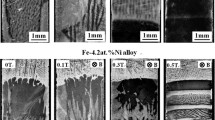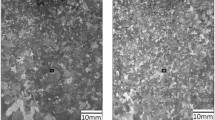Abstract
A new process for the production of metal matrix composites, whereby molten metal is forced into the interstices of a fibrous preform using electromagnetic body forces, is presented. These forces are created by subjecting the molten matrix to a concentrated transient magnetic field which, in turn, induces intense eddy currents in the melt. This gives rise to Lorentz forces which propel the metal into the preform. Equations governing the mechanics of Lorentz force infiltration of an axisymmetric preform surrounded by molten metal are solved numerically. A finite difference algorithm is applied to solve Maxwell's equation of electromagnetic field propagation and to determine the flux density as a function of radial position. The resulting Lorentz force is then calculated and balanced with the inertial, fluid friction and capillary forces, taking preform compression into account, to predict infiltration velocity and cumulative infiltration distance. Apparatuses were designed and constructed to infiltrate cylindrical preforms of 24 vol pct 3-μm-diameter chopped alumina fiber preforms with commercial purity aluminum. Two capacitor banks were charged from 1 to 4 kV and rapidly discharged to produce magnetic pulses of up to 4 tesla peak, at frequencies of 2 to 3 kHz in the infiltrating furnace. A commercial MAGNEFORM unit was also used to produce fields of up to 5 tesla at 5.6 kHz.-Sound composite samples were produced, to a depth of 1.8 mm into the preforms, with little or no breakage of fibers. Good agreement between theoretical model predictions and experimentally measured infiltration depths was demonstrated. Primary process variables for a given matrix-preform system, were the number of discharges, the magnetic pulse intensity and frequency, and the melt ring thickness. The model predicts a pulse frequency below which infiltration does not occur and an optimum frequency for maximum infiltration depth. Successive pulses are predicted to produce only slightly decreasing increments in infiltration depth with the parameters explored, indicating that the process allows greater infiltration depths than were attained with preforms and apparatuses used in this work.
Similar content being viewed by others
References
K.K. Chawla:Composite Materials, Science and Engineering, Springer-Verlag, New York, NY, 1987, pp. 101–33.
S. Caron and J. Masounave: inFabrication of Particulates Reinforced Metal Composites, Proc. Conf., Montreal, 1990, J. Masounave and F.G. Hamel, eds., ASM International, Metals Park, OH, 1990, pp. 79–86.
Treatise on Materials Science and Technology, R.K. Everett and R.J. Arsenault, eds., Academic Press, Boston, MA, 1991.
A. Mortensen, J.A. Cornie, and M.C. Flemings:J. Met., 1988, vol.40, pp. 12–19.
A. Mortensen: in12th Risø Int. Symp. on Metallurgy and Materials Science: Metal Matrix Composites—Processing, Microstructure and Properties, N. Hansen, ed., Proc. Conf., Roskilde, Denmark, 1991, Risø National Laboratory, pp. 101–21
K.M. Atsushei: Japanese Patent No. 60-29433, 1985.
L.J. Masur, A. Mortensen, J.A. Cornie, and M.C. Flemings:Metall. Trans. A, 1989, vol. 20A, pp. 2549–57.
J. Szekely:Fluid Flow Phenomena in Materials Processing, Academic Press, New York, NY, 1979, pp. 175–203.
R.L. Stoll:The Analysis of Eddy Currents, Clarendon Press, Oxford, 1974.
A.E. Scheidegger:The Physics of Flow through Porous Media, 3rd ed. University of Toronto Press, Toronto, 1974, pp. 152–67.
S. Ergun:Chem. Eng. Prog., 1952, vol. 48 (2), pp. 89–94.
I.F. Macdonald, M.S. El-Sayed, K. Mow, and F.A.L. Dullien:Ind. Eng. Chem. Fundam, 1979, vol. 18, pp. 199–208.
A. Mortensen, L.J. Masur, J.A. Cornie, and M.C. Flemings:Metall. Trans. A, 1989, vol. 20A, pp. 2535–47.
A.S. Sangani and A. Acrivos:Int. J. Multiphase Flow, 1982, vol. 8, pp. 193–206.
J.B. Keller:J. Fluid Mech.., 1964, vol. 18, pp. 94–96.
A. Mortensen and T. Wong:Metall. Trans. A, 1990, vol. 21A, pp. 2257–63.
O. Coulaud, P. Morel, and J.P. Caltagirone:J. Fluid Mech. 1988, vol. 190, pp. 393–407.
G.S. Beavers and E.M. Sparrow:J. Appl. Mech. 1969, Dec., pp. 711–14.
J. Crank:The Mathematics of Diffusion, Clarendon Press, Oxford, 1985, pp. 137–59.
J. Sommer and A. Mortensen: Massachusetts Institute of Technology, Cambridge, MA, unpublished research, 1991.
H. Kaufmann and A. Mortensen: Aluminium Ranshofer, Ranshofer, Austria and Massachusetts Institute of Technology, Cambridge, MA, unpublished research, 1989.
A. Mortensen:Mater. Sci. Eng. 1991, vol. A135, pp. 1–11.
A. Mortensen:Metall. Trans. A, 1990, vol. 21A, p. 2287.
R.M. Andrews: Sc.D.Thesis, Massachusetts Institute of Technology, Cambridge, MA, 1991.
Author information
Authors and Affiliations
Rights and permissions
About this article
Cite this article
Andrews, R.M., Mortensen, A. Lorentz force infiltration of fibrous preforms. Metall Trans A 22, 2903–2915 (1991). https://doi.org/10.1007/BF02650251
Received:
Issue Date:
DOI: https://doi.org/10.1007/BF02650251




